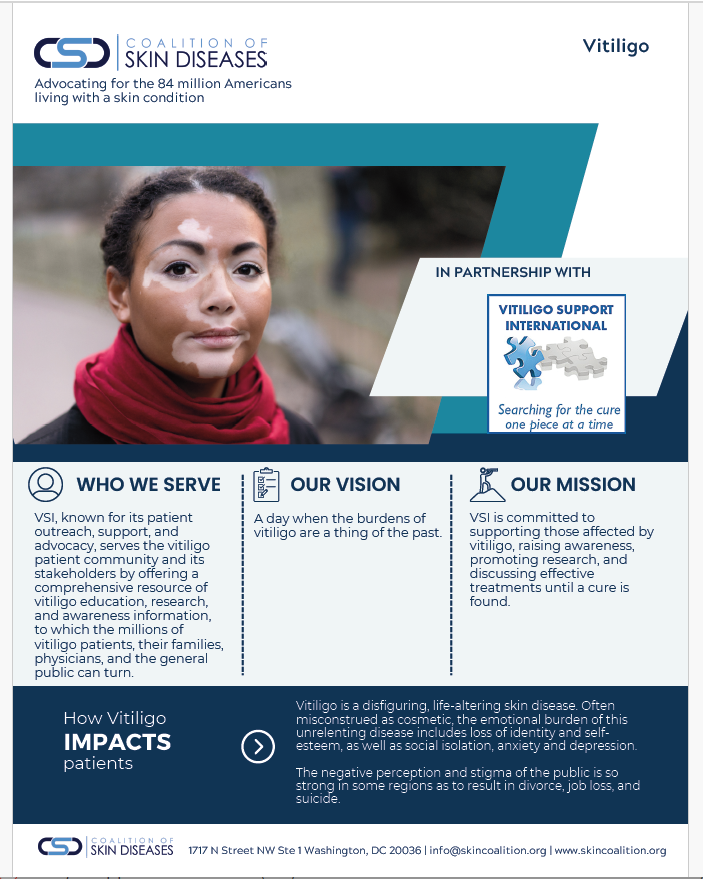Non-Segmental Vitiligo (NSV) includes all types of vitiligo except segmental, such as focal vitiligo (pigment loss limited to one, or very few areas), acrofacial vitiligo (pigment loss occurring only on the face and extremities such as hands and feet), and the most common, generalized vitiligo (pigment loss on both side of the body in a mirror-like image, such as both hands or both knees). NSV typically begins on areas such as the hands, wrists, around the eyes or mouth, or on the feet, then spreads to areas such as the neck, chest, knees and legs. NSV is considered to be progressive, but has cycles of spreading and cycles of stability.
Non-Segmental Vitiligo (NSV) includes all types of vitiligo except segmental, such as focal vitiligo (pigment loss limited to one, or very few areas), acrofacial vitiligo (pigment loss occurring only on the face and extremities such as hands and feet), and the most common, generalized vitiligo (pigment loss on both side of the body in a mirror-like image, such as both hands or both knees). NSV typically begins on areas such as the hands, wrists, around the eyes or mouth, or on the feet, then spreads to areas such as the neck, chest, knees and legs. NSV is considered to be progressive, but has cycles of spreading and cycles of stability.
Segmental Vitiligo (SV) most often begins at an early age and affects only one area, on one side of the body, such as one side of the face or neck. It typically spreads fairly quickly at the onset, then slows and remains stable after a year or so. More than half of those affected by SV will also have patches of white hair.
Mixed Vitiligo (MV) begins as segmental vitiligo, then later progresses into nonsegmental vitiligo, becoming Mixed Vitiligo.
The earlier you begin treatment, the better the response. The face generally responds well, and the feet and hands are among the most difficult areas to repigment.
Stabilizing: If the vitiligo is actively spreading, the first line of action will be to bring the immune response under control. Some physicians prescribe oral or injected corticosteroids to stabilize, as well as full body phototherapy. Treatments must be used correctly and consistently, for a minimum of 4-6 months, to begin seeing results.
Phototherapy: Narrowband UVB light (NB-UVB) – now considered the gold standard of treatment for vitiligo covering more than 10% of the body. In addition to use in physician’s offices, these units are available for home use.
Excimer laser – A targeted NB machine typically using the 308 nm portion of the spectrum. Laser can be very effective for smaller areas of stable vitiligo. As it treats a small area, it is inefficient for larger areas or percentages. Results from laser treatments frequently occur more quickly than with other treatments.
Topicals: Immunomodulators: such as tacrolimus, and high potency steroids such as Clobetasol, Betamethasone and Fluocinonide
Depigmentation: Removing the remaining pigment is an option for those with a greater percentage of depigmentation. This therapy uses a topical cream called monobenzone, which can only be purchased from a compounding pharmacy. For a list of pharmacies who make and ship monobenzone, contact VSI.
Vitiligo Support International (VSI) is a patient-focused and patient-driven 501(c) (3) nonprofit organization dedicated to serving individuals affected by vitiligo and improving the quality of their lives through support, education and advocacy. VSI, known for its global outreach and networking capabilities, also offers a wide range of support services to the broader professional community.

VSI Serves the Vitiligo Community by:
For more information, or to support this important work:
Visit:
Vitiligo Support International
www.vitiligosupport.org
Or Contact Us:
Email: [email protected]
Phone: 434-326-5380

Connect with your federal legislators to speak up for dermatological conditions today.